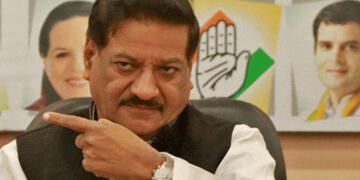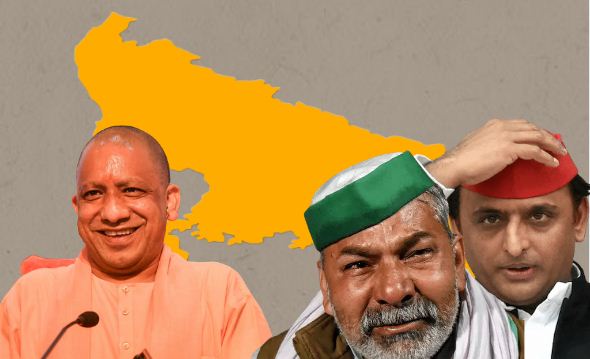Uttar Pradesh – the state that decides who will form governments in New Delhi. The road to Delhi goes through Lucknow. This is a historical adage that we all know about in India. But Uttar Pradesh is a tricky state. No party can win Uttar Pradesh riding on one issue, or for that matter, even on the popularity of one leader. The complexities of Uttar Pradesh’s electoral realities are much more fascinating than mere unipolarities or singular issues. It is for this reason that all parties – including the BJP – are on the edge for the upcoming UP polls this time. For the Bharatiya Janata Party, Western Uttar Pradesh could play a major spoilsport, and it needs to get its act straight here immediately.
Just as the road to Delhi goes through Lucknow; the road to Lucknow goes through Western UP. Of 71 Assembly seats across 14 western UP districts where Jats are particularly dominant, BJP had bagged 51 in 2017. BJP candidates won over 100 of western Uttar Pradesh’s nearly 135 segments in 2017. This propelled BJP’s state-wide numbers. BJP won 312 of UP’s 403 seats and 13 more with alliance partners. Clocking an unprecedented three-fourths majority, the saffron party’s vote share touched 40 per cent in 2017.
The Jat Factor
Here’s what has got the BJP jittery. Jats are not traditional BJP voters, and the party knows this. The community has voted overwhelmingly for the BJP only for three elections now – 2014, 2017 and 2019. In 2012, just 7 per cent had voted for the BJP. In 2014 Lok Sabha polls, 77 per cent voted for it. By the time the 2017 assembly polls dawned, 91 per cent of Jats embraced the BJP.
So, in 2012, the Samajwadi Party won the UP-assembly polls. In the 2014, 2017 and 2019, the BJP swept the state. This makes the Jat vote a crucial bellwether segment, which no party can ignore. Currently, the BJP is on thin ice with this critical community. In 2017, 11 BJP MLAs were Jats. Four became ministers in the Yogi Adityanath government. After the 2019 Lok Sabha polls, three BJP MPs were Jats. But much has changed since.
The Muslim Factor
In many districts of Western Uttar Pradesh, Muslims are a dominant vote bank. This makes them crucial to the BJP’s political calculus. The saffron party has never really banked on Muslim voters. They have historically voted for the Samajwadi Party or the RLD. The obvious question which rises here is this: Is RLD not a Jat party?
Here’s where things get tricky for the BJP. Jats have voted for the BJP as ‘Hindus’ only in the past three elections in Uttar Pradesh. Historically, however, the Jats and Muslims of Western Uttar Pradesh have always voted as a collective bloc – making the SP and RLD dominant political forces in the region. It now appears that Jats are willing to give their alliance with Muslims another shot.
Read more: Jewar Airport: Noida, Ghaziabad and entire Western UP will never be the same again
The 2013 Muzaffarnagar riots upended this alliance. Jats abandoned the Muslim community. They voted for the BJP as ‘Hindus’. But 2013 was nine years ago. And that, in purely electoral terms, is a very long time. Jats are cosying with Muslims once again. “Bhaichara committees” between Jats and Muslims are now propping up all across Western UP, and the politics of the region is at the cusp of a fascinating make-or-break situation.
The Farmers Factor
Jats are farmers. At the Ghazipur border – the crowd of protestors agitating against the now-withdrawn farm laws belonged to Jats from Western Uttar Pradesh and Uttarakhand’s Terai region. What does that tell you?
It’s rather simple. Jats have been a crucial vote bank for the BJP in the past three major elections in Uttar Pradesh. But the farm laws and the protests against them have changed many equations. Jats are now annoyed and want to get back at the BJP. They want to teach the BJP a lesson electorally, which is why despite the scars of the 2013 riots, they are leading efforts to ally with the Muslims and vote collectively in the coming elections.
Bhartiya Kisan Union and its Politics
Rakesh Tikait might not be fighting the elections. Yet, Jats in Western UP – especially in areas like Baghpat, Muzaffarnagar, Shamli, Meerut and other districts will vote for whichever party the Bhartiya Kisan Union (BKU) of Rakesh Tikait puts its weight behind or so Tikait would hope, right? Out of the 76 Assembly seats in Western UP, BJP bagged 66 in 2017. So BJP’s Jat voter base started strong, but the highly political farmers’ protest has compromised this vote base in the last one year.
For as long as the farmers’ protest was on, sitting BJP MLAs were not allowed to visit their constituencies in Western UP. They were shown black flags and protested against. Therefore, the BJP is willing to not take any chances. It knows it needs to maintain its numbers in this region, but it is not banking on Jats alone.
There is another interesting caveat to be added. RLD is afflicted by inner politics as well. If Tikait were to fight on an RLD ticket and win, he will hands-down become a bigger Jat leader than Jayant Chadhary and Ajit Singh. The duo might not be open to risk their own political capital to propel Tikait’s electoral rise.
Reverse polarisation against the Jat-Muslim alliance might just turn out to be a game changer for the BJP. This is what the saffron party is banking on, and working towards.
BJP’s Outreach in Western Uttar Pradesh
The BJP is not counting on Jats alone. Things are not going to be easy for the saffron party in West UP, which is why it is wooing other communities to its fold. On top, the focus are the Gujjars. The BJP has been propping up and honouring Gujjar heroes like Dhan Singh Kotwal and Raja MihiraBhoja.
The BJP has a comprehensive plan-B. Western UP must be retained. The BJP can afford to lose some singular and isolated seats in Western UP, but a rout is something it simply cannot accommodate in its state-wide political calculus. So, it has been trying to bring together a slew of Dalit and extremely backward castes such as Sainis, Kashyaps, Pals and Prajapatis present in sizeable numbers in the region.
Today the Samajwadi Party, the Rakesh Tikait led political front and Muslim Parties are all in the fray. While a Jat-Muslim unity is being engineered by some, it remains to be seen whether that will reap any gains at all, especially with SP and Owaisi polarising the Muslim vote and driving Jat-Hindus towards the BJP.
Ultimately, it will all boil down to how well the Jats and Muslims can come together to vote for the Samajwadi Party-RLD combined. For SP and RLD, the purported Jat-Muslim unity is the only card they have in Western UP. Jats, however, might retain their support for the BJP now that the farm laws have been repealed, for the greater good of the Hindu cause. There is an equal, if not higher chance of them turning against the saffron party.
The BJP still has many cards to play in Western UP. But winning margins are likely to be thin in UP this time around; more so in the state’s Western region. The BSP is simply absent in these elections. Mayawati does not seem interested to come to power. Uttar Pradesh is witnessing a simple yet fascinating electoral battle between two sides. The BJP on one side, and SP-RLD on the other.
In a bipolar fight such as this – vote fragmentation and division will be reduced, which is why margins of victory will narrow down as well. This is all the more reason why BJP cannot take Western UP lightly. It needs to go all-out in this region if it wishes to repeat the 2017 results with minimal losses to its tally.
Now that it does not have the baggage of the farm laws over its shoulders, and with Prime Minister Modi himself announcing the withdrawal of the same – Uttar Pradesh is still for the BJP to take. At this point, it would not be wrong to say that the farm laws were rolled back with an eye on Western UP. To bring fundamental changes to India, the BJP needs to retain power. That will not happen if it faces a rout in Western UP. That’s how important the region is.



































Which begs the question? Why did the BJP rush in foolishly with the revolutionary farm laws with impending elections in Punjab & UP, that were the epicenter of the farmer protests? Why did they not wait for both state elections to finish before rolling out the farm laws? The party failed spectacularly on both intelligence inputs & communication. Now even if it wins both states handsomely, rolling out the much needed farm reforms will be very challenging after they have assumed a political & religious color!